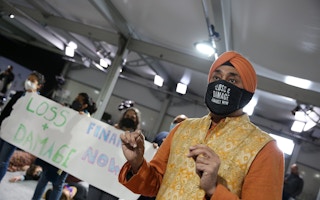Tensions between the richer North and less developed South are likely to reach new heights at the United Nations Climate Change Conference or COP27 in Egypt, as developing countries press for the establishment of a loss and damage (L&D) finance facility. This facility is expected to provide financial compensation to developing countries that have historically contributed very little to global warming but are highly vulnerable to the consequences of climate change.
L&D generally refers to unavoidable destruction caused by climate change, which can occur suddenly or over a long period of time. These include economic L&D, such as damage to property, and non-economic L&D such as loss of life, biodiversity and cultural heritage.
As Chair of the Alliance of Small Island States (AOSIS), Vanuatu proposed the establishment of a L&D finance facility in 1991, but the proposal was rejected by developed countries. The term L&D did not resurface again until the COP13 negotiations in Bali in 2007. It was not until the COP19 negotiations that the Warsaw International Mechanism for Loss and Damage (WIM) was established to enhance knowledge, support and collaboration on L&D issues. From 2018 onwards, growing scientific evidence suggests that there are irreversible losses that cannot be addressed by mitigation and adaptation measures. This has helped to raise the importance of L&D in climate negotiations.
Diverging self-interests continue to block international consensus on L&D. At COP26 in Glasgow in 2021, the Group of 77 and China pushed for the establishment of an L&D finance facility. However, developed countries — which have contributed the most to global warming — were unwilling to provide financial support, fearing that it would be construed as an admission of legal liability that may spark large-scale climate litigation actions. As a compromise, the Glasgow Dialogue was set up at COP26 as a three-year discussion forum on L&D.
Developed countries reportedly blocked L&D from the formal COP27 agenda during the Bonn Climate Conference in June 2022. However, as host of COP27, Egypt has promised to put L&D at the forefront of negotiations. Over 400 organisations across the world have also signed a petition calling for L&D finance to be discussed at COP27.
“
At the global level, many NGOs, small-island developing states, least developed countries and a few developing countries have been fighting a very hard battle on L&D. Aside from the Philippines, Southeast Asian countries seem rather quiet when it comes to supporting the call for a L&D finance facility.
Some developed countries, however, are willing to discuss L&D financing. Scotland, Denmark and the Wallonia region of Belgium have given a total of US$15 million for climate-related L&D — a positive but symbolic gesture. Germany has also proposed the establishment of the “Global Shield” — a pilot programme to extend insurance coverage for people in climate-vulnerable countries, while New Zealand is considering how to provide L&D finance to their partner countries.
Southeast Asian countries will be paying attention to L&D discussions at COP27 because they also suffer significant climate-related L&D. Indeed, L&D has been discussed in many countries’ Nationally Determined Contributions (NDCs) — national plans to mitigate and adapt to climate change. The NDCs of Vietnam, the Philippines, and Myanmar discuss economic L&D rather substantially. However, the NDCs of Laos, Cambodia, Malaysia and Indonesia only mention this issue in passing. Other Southeast Asian countries’ NDCs, however, do not use the term L&D when discussing the destructive impacts of climate change.
Climate-related L&D will affect all Southeast Asians intergenerationally. Vietnam’s NDC suggests, for example, that L&D caused by natural disasters between 1995 and 2017 cost approximately US$2.7 billion in total. If the sea level rises by one metre by 2100, around six per cent of the country’s land will be under water, causing significant damage to Vietnam’s rice industry. In addition to the loss of lives, the Philippines’ NDC suggests that L&D from extreme weather amounted to four per cent of gross domestic product (GDP) in 2013 due to destruction caused by Super Typhoon Haiyan. In October and November 2020 alone, typhoons resulted in US$852 million worth of L&D in agriculture and infrastructure. Myanmar’s NDC also discusses L&D to rural housing and people’s well-being. Cyclone Nargis in 2008, for example killed over 138,000 and displaced over 800,000 people. The economic L&D in Myanmar from cyclone Komen in 2015 was estimated to be US$1.51 billion — equivalent to 3.1 per cent of the country’s GDP in 2014/2015. In Laos, flooding in 2018 resulted in the loss of around US$371 million, or two per cent of GDP.
At the global level, many NGOs, small-island developing states, least developed countries and a few developing countries have been fighting a very hard battle on L&D. Aside from the Philippines, Southeast Asian countries seem rather quiet when it comes to supporting the call for a L&D finance facility. Exceptions include a regional workshop in the Philippines last August where participants from seven Southeast Asian countries called for the creation of a L&D finance facility that will empower vulnerable people and communities.
Given drastic consequences of climate change, Southeast Asian countries can no longer free-ride on the courage and hard work of other developing nations in pushing for L&D recognition. Southeast Asia undeniably suffers from L&D that cannot be addressed through only national climate mitigation and adaptation measures. Therefore, it is high time that Southeast Asian governments unite with other developing countries to increase collective negotiation power. ASEAN’s joint statement on climate change for COP26 in 2021 recognised the importance of L&D but it did not explicitly call for a L&D facility. Perhaps in this year’s joint statement, ASEAN will finally join the global call for the establishment of a L&D finance facility at COP27.
Prapimphan Chiengkul is visiting fellow with the Climate Change in Southeast Asia Programme, ISEAS – Yusof Ishak Institute.
This article was first published by ISEAS – Yusof Ishak Institute as a Fulcrum commentary.









